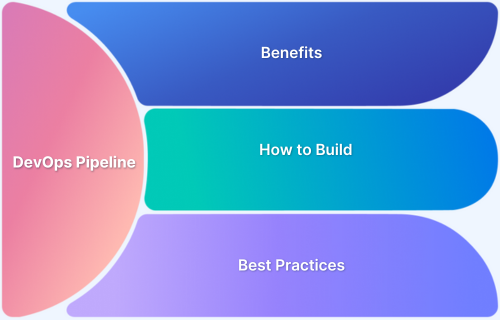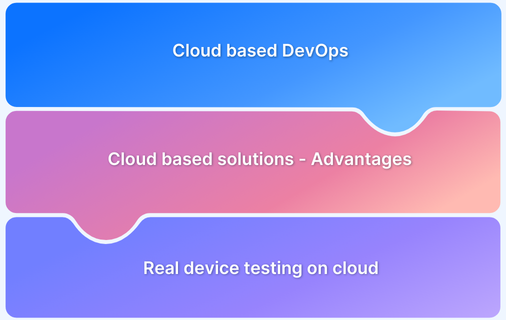DevOps emphasizes integrating development and operations to deliver software rapidly and reliably. Central to this approach is test automation, which ensures that software changes are validated efficiently and consistently throughout the development lifecycle. Properly implemented automated testing accelerates feedback, improves product quality, and minimizes the risk of defects reaching production.
Overview
Automated testing in DevOps uses scripts and tools to continuously validate software during development and deployment. This integration supports rapid feedback cycles and consistent quality in CI/CD pipelines.
Key Aspects of Automated Testing in DevOps
- Continuous Integration of Automated Tests: Tests are executed automatically with every code change to catch issues early in the development cycle.
- Frequent and Rapid Test Execution: Tests run quickly and frequently to support fast-paced DevOps workflows without slowing delivery.
- Cross-Team Collaboration: Developers, testers, and operations teams work together to design, implement, and maintain automation within the pipeline.
- Multi-Environment and Platform Testing: Automated tests cover different environments and platforms to ensure software reliability across diverse conditions.
- Test Data Management: Efficient test data handling enables realistic and repeatable test scenarios in continuous delivery pipelines.
- Selective Test Case Automation: Prioritizing test cases for automation based on impact, frequency, and complexity optimizes resources and results.
- Tool Integration and Compatibility: Choosing tools that seamlessly integrate with existing DevOps toolchains enhances automation efficiency and maintainability.
- Balanced Automation Approach: Combining automated and manual testing prevents over-automation, ensuring appropriate test coverage and quality.
This article covers the fundamentals of test automation in DevOps, including its stages, integration with CI/CD, and overall benefits.
Understanding Automated Testing in DevOps
Test automation includes using software tools and scripts to execute predefined tests on an application automatically. Instead of relying on manual testing for each release or code change, automated testing enables consistent, repeatable, and faster validation of functionality, performance, and user flows.
In DevOps, automated testing supports continuous integration and delivery by providing quick feedback on code quality and helping detect defects early in the development lifecycle.
Test Automation Stages
Test automation in DevOps involves multiple testing layers, each targeting different aspects of application quality. These stages are aligned with the software delivery pipeline and help ensure reliability at every level:
- Unit Testing: Focuses on individual functions or components. These are typically the first tests written and are executed with every code commit to catch low-level defects early.
- Integration Testing: Validates how different modules or services interact. Automated integration tests help identify issues in data flow, APIs, and dependencies between components.
- Regression Testing: Ensures that new code changes do not break existing functionality. Automated regression suites are critical for maintaining stability across frequent deployments.
- End-to-End Testing: This simulates real user scenarios across the full application stack. It is automated to verify critical workflows, such as login, checkout, or form submission, in production-like environments.
- Exploratory Testing (Partially Automated): While largely manual, exploratory testing can benefit from automation in setup, data generation, and logging. Automated tools can support testers in quickly validating edge cases or UI behavior.
To support automated testing in DevOps at scale, teams rely on platforms like BrowserStack that provide cloud-based infrastructure. BrowserStack enables automated tests to run across real browsers and devices, making it easier to integrate testing seamlessly into CI/CD pipelines.
How Automation Testing Fits into DevOps
While the DevOps lifecycle encompasses planning, development, integration, delivery, and monitoring, automated testing enables continuous, high-quality software delivery. It supports continuous testing, a practice essential for validating code at every stage of the pipeline and ensuring rapid, reliable releases.
By integrating test automation into DevOps workflows, teams can achieve the following:
- Faster Defect Detection and Resolution: Automated test scripts, triggered with each code change, help identify bugs early, reducing the cost and effort of fixing them later in the cycle.
- Accelerated Delivery Cycles: Automation significantly reduces the time required to execute repetitive test cases compared to manual testing, supporting faster deployment without compromising quality.
- Reduced Human Error: Automated tools ensure consistency and accuracy across test executions, eliminating the variability introduced by manual testing.
- Scalable and Repeatable Testing: Automated frameworks can efficiently run test suites across multiple environments, devices, or configurations, making regression and integration testing scalable.
- Higher Reliability and Confidence in Releases: Continuous validation through automated tests increases confidence in the stability and performance of each release, even in high-frequency deployment environments.
Unlike traditional QA, which typically initiates testing after development is complete, DevOps integrates testing early and continuously throughout the software delivery lifecycle. Testing starts during development and continues through build, staging, and production environments, ensuring quality at every step.
To support this model, DevOps teams must:
- Adopt a Robust Automation Framework: An automation framework enables modular, maintainable test scripts, simplifies test case management, and integrates with CI/CD tools like Jenkins, GitHub Actions, or GitLab CI.
- Select the Right Automation Tools: Tools should align with the tech stack, support the required test types (unit, integration, end-to-end), and offer smooth integration with DevOps pipelines.
- Foster Cross-Functional Collaboration: Developers, testers, and operations teams must collaborate to design, execute, and maintain automation strategies that meet delivery and quality goals.
In essence, automation testing is not just a support function in DevOps; it is a key enabler of agility, scalability, and reliability across the entire software development lifecycle.
Pro Tip: Deliver higher-quality releases faster by leveraging parallel test execution on the BrowserStack cloud. Leading agile teams use BrowserStack’s parallel testing to complete builds in under ten minutes, accelerating their release cycles without compromising quality.
Building a DevOps Test Automation Strategy
Developing an effective test automation strategy within a DevOps environment is essential to achieve continuous testing and delivery at scale. A well-crafted strategy aligns automation efforts with business goals, optimizes resource use, and ensures high software quality without slowing down the development pipeline.
Key steps to build a successful DevOps test automation strategy include:
- Define Clear Objectives: Establish measurable goals for automation, such as reducing manual testing time, improving test coverage, or accelerating release frequency.
- Prioritize Test Cases for Automation: Focus on high-value, repetitive, and stable test cases like unit tests, regression tests, and critical user journeys to maximize ROI and reduce maintenance overhead.
- Select the Right Tools and Frameworks: Choose automation tools that integrate with your CI/CD pipeline, support your application technology stack, and allow scalable test execution.
- Design a Modular and Maintainable Test Suite: Develop reusable test scripts and adopt best practices in scripting and version control to simplify maintenance as the application evolves.
- Integrate Testing into the CI/CD Pipeline: Automate test execution to trigger with every build, ensuring immediate feedback and early defect detection.
- Implement Parallel and Cross-Platform Testing: Use cloud-based testing platforms to run tests concurrently across multiple environments, devices, and browsers, speeding up the testing cycle.
- Ensure Effective Collaboration: Foster communication and shared ownership between development, QA, and operations teams to streamline testing workflows and address issues promptly.
- Monitor and Optimize: Continuously track test performance, failure rates, and coverage metrics to identify bottlenecks and improve the automation process.
By following these principles, organizations can build a resilient automation strategy that supports the fast-paced, iterative nature of DevOps, delivering reliable software at scale.
Read More: How to perform Cross-Device Testing
Selecting DevOps Automated Testing Tools
Choosing the right automated testing tools is crucial to successfully implementing test automation within a DevOps environment. The ideal tools should align with your team’s technology stack, integrate smoothly into your CI/CD pipelines, and support your testing goals.
Consider the following factors when selecting DevOps automated testing tools:
- Compatibility with Application Technology: Ensure the tool supports the programming languages, frameworks, and platforms your application uses, whether web, mobile, API, or desktop.
- Integration with CI/CD Pipelines: The tool must seamlessly connect with your existing DevOps tools, such as Jenkins or Azure DevOps, to enable automated test execution during builds.
- Scalability and Parallel Execution: Tools should support running tests in parallel across multiple environments, browsers, and devices to accelerate testing cycles.
- Ease of Script Development and Maintenance: Choose tools with user-friendly scripting capabilities, good documentation, and community support to reduce the learning curve and ongoing maintenance effort.
- Reporting and Analytics: Effective reporting features help quickly identify failures and trends, enabling faster debugging and continuous improvement.
- Cost and Licensing: Balance features with budget constraints; consider open-source options versus commercial tools based on your team’s requirements and resources.
- Cloud vs. On-Premise Support: Decide whether a cloud-based tool fits your infrastructure and scalability needs or if an on-premise solution is required for compliance or security reasons.
Read More: Best 20 Test Automation Frameworks
CI/CD Environments and Testing Data
While automated testing is essential for DevOps success, teams often struggle to implement it early in the CI/CD pipeline due to the lack of pristine, ready-to-use environments and reliable test data.
Developing automated tests is only part of the challenge; without consistent environments and well-managed data, tests become flaky, slow, or even unusable. To overcome these blockers, teams must:
- Commit to Building a Robust Testing Infrastructure: Early collaboration between developers, QA, and DevOps is key to aligning on the testing approach. Agree on how and when environments will be provisioned and what data will be used.
- Provision Ephemeral Test Environments Early: Creating disposable, isolated environments on demand (e.g., using containers or cloud instances) allows for parallel, conflict-free testing that more closely mirrors production.
- Automate Test Data Generation and Management: Developers should design applications with testing in mind, such as enabling API-based test data creation and supporting dedicated test user accounts. This ensures that environments can be reliably populated for every test run.
- Speed Up Feedback Loops: Investing in early-stage test infrastructure enables faster iterations, more reliable test execution, and a shorter path to production.
To support this workflow, BrowserStack offers a cloud-based Selenium Grid that integrates directly into your CI pipeline. It enables fast, on-demand testing across real devices and browsers without the burden of maintaining in-house infrastructure.
BrowserStack Automate also supports Cypress, Playwright, Puppeteer, and raw JavaScript execution via its JS testing API, making it flexible and scalable for modern DevOps teams.
Read More: Agile vs DevOps: What’s the Difference?
Avoid Over Automation
While test automation is essential for speeding up delivery and ensuring quality in DevOps, automating everything can lead to inefficiencies, high maintenance costs, and unreliable results.
Over-automation often occurs when teams attempt to automate tests that are unstable, low-value, or require frequent updates due to changing requirements.
Here’s how to avoid over-automation:
- Automate High-Value, Repeatable Tests: Focus on tests that run frequently and offer the greatest ROI, such as unit tests, regression suites, and critical user flows.
- Avoid Automating Exploratory or Unstable Scenarios: Tests that require human judgment (like exploratory testing) or frequently changing UI elements are better handled manually to avoid constant script maintenance.
- Regularly Review and Prune Your Test Suite: Identify and remove redundant or flaky tests that add little value or slow down your CI/CD pipeline.
- Balance Speed with Test Coverage: Aim for smart test coverage rather than exhaustive automation. A lean, stable test suite integrated into the pipeline is more effective than a large, unreliable one.
- Start with a Clear Automation Strategy: Define goals, priorities, and selection criteria for test automation early in the DevOps process to ensure focus and alignment.
By avoiding the temptation to automate everything, teams can maintain a fast, reliable, and maintainable test suite that supports continuous delivery without unnecessary overhead.
Read More: What is Change Management in DevOps?
How to select test cases and create test automation flows
After covering the technical details of test automation and DevOps, you can now examine the implementation. You must first plan out your release pipeline before you can integrate automated testing into your DevOps lifecycle. The following four steps can be used to accomplish this:
- Determine every phase of your release.
- Determine the checkpoints and prerequisites needed for a build to reach production.
- Determine the feedback mechanism needed for prompt error identification and correction.
- List all the activities, services, and operational processes involved in a release cycle.
Read More: DataOps vs DevOps: Key Differences
Building the automation flows comes next. It depends on the tool, the testing plan you’ve put in place, and industry standards.
- You can develop the automation flows slowly and gradually expand coverage by automating simpler processes that are repeatable and predictable.
- It is simpler to identify the problem when a test case fails when you test one thing at a time. Instead of condensing multiple tests into a single test case, use the automation tool to create reusable components. Taking the logic from other test cases is simpler.
- Building discrete, self-contained automated test cases can provide parallel testing execution across several environments.
- The cooperation and collective wisdom of the team is essential to the success of automation testing. It is important to use a test automation platform that the entire team can use.
As a result, no-code test automation may be the best option for DevOps testing services since it enables the various teams to operate seamlessly through the release pipeline.
Read More: What is Continuous Testing in DevOps
What to look for when choosing the best test automation tool for DevOps
Selecting the right test automation tool is essential for building an effective DevOps testing strategy. The tool you choose directly impacts your team’s agility, test coverage, and ability to scale continuous testing.
An ideal DevOps automation tool should:
- Be Accessible to All Stakeholders: Support collaboration across developers, testers, operations teams, and even management with an intuitive interface and shared visibility.
- Integrate Seamlessly with CI/CD Pipelines: Work effortlessly with your CI/CD tools (like Jenkins, GitHub Actions, GitLab CI, etc.) to enable smooth and continuous test execution.
- Support Diverse Infrastructure Setups: Run consistently across cloud, on-premise, or hybrid environments without requiring major infrastructure changes.
- Minimize Test Maintenance Effort: Offer stable test execution with features that reduce test flakiness and simplify maintenance over time.
- Enable Low-Code or No-Code Automation: Allow non-developers to contribute to automation through user-friendly interfaces or low-code features, without relying heavily on scripting.
- Preserve Tester Productivity: Streamline workflows without distracting testers from their core responsibilities, such as exploratory and edge-case testing.
- Have a Minimal Learning Curve: Be easy to adopt across the team, minimizing onboarding time and avoiding delays in release cycles.
- Support Collaboration and Reusability: Make it easy to share, review, and reuse automation scenarios across teams to improve efficiency and consistency.
Why Choose BrowserStack for Automated DevOps Testing
Integrating automated testing into the DevOps lifecycle is crucial for delivering high-quality software quickly. BrowserStack offers a comprehensive solution tailored to meet the demands of modern DevOps workflows. Here’s why BrowserStack stands out:
- Seamless CI/CD Integration: BrowserStack integrates effortlessly with popular CI/CD tools like Jenkins, GitLab CI/CD, and Azure DevOps. This helps ensure that automated tests can be triggered with every code commit, providing immediate feedback and facilitating continuous testing throughout the development cycle.
- Real Device and Browser Testing: Unlike emulators or simulators, BrowserStack allows testing on a vast array of real devices and browsers. This ensures that applications are validated under real-user conditions, leading to more reliable and accurate test results.
- Parallel Test Execution: Accelerate your testing process by running multiple tests simultaneously. BrowserStack’s parallel testing capabilities significantly reduce testing time, enabling faster release cycles.
- Scalable Infrastructure: With its cloud-based infrastructure, BrowserStack allows teams to scale their testing efforts effortlessly. Whether you’re a startup or an enterprise, you can adjust your testing capacity based on project needs without the overhead of maintaining physical devices.
- Comprehensive Test Coverage: BrowserStack offers access to over 3500+ real device and browser combinations. This extensive coverage ensures that your application is tested across a wide range of environments, enhancing its compatibility and user experience.
- Unified Test Management: Gain insights into your testing efforts with BrowserStack’s integrated test management features. Monitor test performance, identify bottlenecks, and make informed decisions to improve your testing strategy continuously.
Conclusion
Automated testing is a cornerstone of modern DevOps practices. By enabling continuous testing across the software development lifecycle it helps teams detect issues early, accelerate release cycles, and maintain high-quality standards at scale.
From selecting the right test cases and tools to setting up CI/CD-ready environments, a robust DevOps automation strategy ensures seamless collaboration, faster feedback, and reduced risk.
Platforms like BrowserStack simplify this process by offering cloud-based infrastructure, real device testing, and integrations with leading CI/CD tools. These tools empower teams to execute reliable, scalable, and efficient automated tests throughout their DevOps pipelines.
Useful Resources for DevOps
Understanding DevOps:
- What is DevOps
- DevOps Shift Left Testing: A Detailed Guide
- What is the ultimate goal of DevOps?
- Benefits of DevOps
- What is DevOps Configuration Management?
- What is Continuous Delivery in DevOps?
- What is a DevOps Pipeline? How to Build One
- What is DevOps Observability (Importance & Best Practices)
- DevOps Testing Strategy
- How to improve DevOps Feedback Loop
- Python For DevOps: An Ultimate Guide
- What is DevOps Automation and How is it Helpful?
- Importance of DevOps Team Structure
- The Role of QA in DevOps
- Top Challenges in DevOps and How to Solve Them
- Top 21 Monitoring Tools in DevOps for 2024







